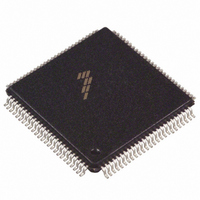DSP56F826BU80E Freescale Semiconductor, DSP56F826BU80E Datasheet - Page 51

DSP56F826BU80E
Manufacturer Part Number
DSP56F826BU80E
Description
IC DSP 80MHZ 31.5K FLASH 100LQFP
Manufacturer
Freescale Semiconductor
Series
56F8xxr
Datasheet
1.DSP56F826BU80E.pdf
(56 pages)
Specifications of DSP56F826BU80E
Core Processor
56800
Core Size
16-Bit
Speed
80MHz
Connectivity
EBI/EMI, SCI, SPI, SSI
Peripherals
POR, WDT
Number Of I /o
46
Program Memory Size
67KB (33.5K x 16)
Program Memory Type
FLASH
Ram Size
4.5K x 16
Voltage - Supply (vcc/vdd)
2.25 V ~ 2.75 V
Oscillator Type
External
Operating Temperature
-40°C ~ 85°C
Package / Case
100-LQFP
Processor Series
DSP56F8xx
Core
56800
Data Bus Width
16 bit
Data Ram Size
9 KB
Interface Type
SCI, SPI, SSI
Maximum Clock Frequency
80 MHz
Number Of Programmable I/os
46
Number Of Timers
2
Operating Supply Voltage
2.5 V
Maximum Operating Temperature
+ 85 C
Mounting Style
SMD/SMT
Minimum Operating Temperature
- 40 C
Lead Free Status / RoHS Status
Lead free / RoHS Compliant
Eeprom Size
-
Data Converters
-
Lead Free Status / Rohs Status
Details
Available stocks
Company
Part Number
Manufacturer
Quantity
Price
Company:
Part Number:
DSP56F826BU80E
Manufacturer:
Freescale Semiconductor
Quantity:
10 000
Part Number:
DSP56F826BU80E
Manufacturer:
FREESCALE
Quantity:
20 000
Part 5 Design Considerations
5.1 Thermal Design Considerations
An estimation of the chip junction temperature, T
Where:
Historically, thermal resistance has been expressed as the sum of a junction-to-case thermal resistance and
a case-to-ambient thermal resistance:
Where:
R
change the case-to-ambient thermal resistance, R
the device, add a heat sink, change the mounting arrangement on the Printed Circuit Board (PCB), or
otherwise change the thermal dissipation capability of the area surrounding the device on the PCB. This
model is most useful for ceramic packages with heat sinks; some 90% of the heat flow is dissipated through
the case to the heat sink and out to the ambient environment. For ceramic packages, in situations where
the heat flow is split between a path to the case and an alternate path through the PCB, analysis of the
device thermal performance may need the additional modeling capability of a system-level thermal
simulation tool.
The thermal performance of plastic packages is more dependent on the temperature of the PCB to which
the package is mounted. Again, if the estimations obtained from R
the thermal performance is adequate, a system-level model may be appropriate.
Definitions:
A complicating factor is the existence of three common definitions for determining the junction-to-case
thermal resistance in plastic packages:
Freescale Semiconductor
θJC
•
•
is device-related and cannot be influenced by the user. The user controls the thermal environment to
T
R
P
R
R
R
Measure the thermal resistance from the junction to the outside surface of the package (case) closest to the
chip mounting area when that surface has a proper heat sink. This is done to minimize temperature variation
across the surface.
Measure the thermal resistance from the junction to where the leads are attached to the case. This definition
is approximately equal to a junction-to-board thermal resistance.
A
D
Equation 1:
θJA
Equation 2:
θJA
θJC
θCA
= ambient temperature °C
= power dissipation in package
= package junction-to-case thermal resistance °C/W
= package junction-to-ambient thermal resistance °C/W
= package junction-to-ambient thermal resistance °C/W
= package case-to-ambient thermal resistance °C/W
T
R
J
θJA
=
T
=
A
R
+
θJC
(
P
D
+
×
R
R
θCA
θJA
56F826 Technical Data, Rev. 14
)
θCA
J
, in °C can be obtained from the equation:
. For example, the user can change the air flow around
θJA
do not satisfactorily answer whether
Thermal Design Considerations
51








